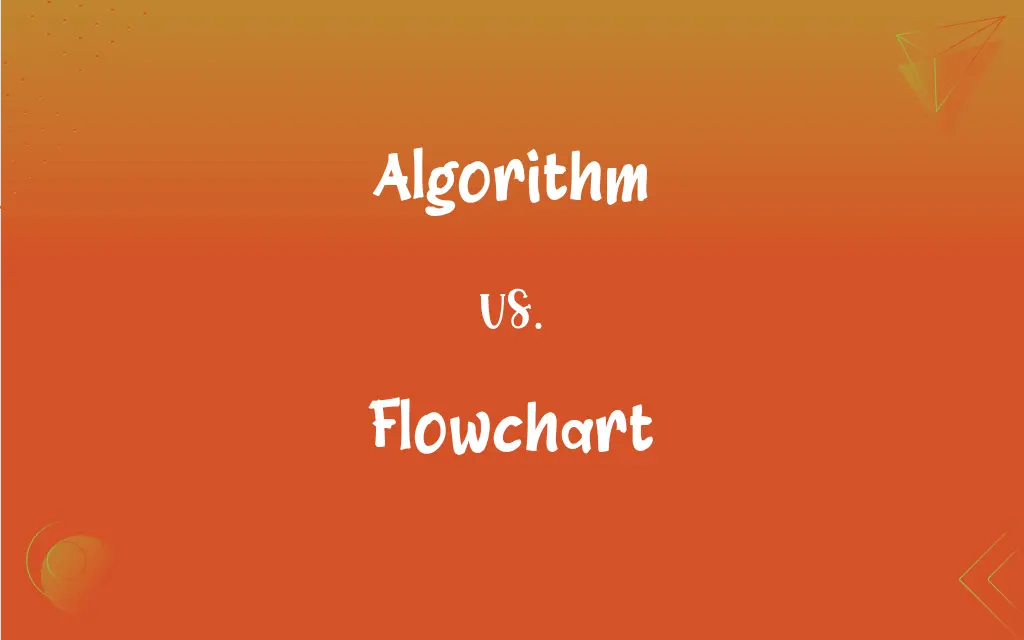Algorithm vs. Flowchart: What's the Difference?
Edited by Janet White || By Harlon Moss || Updated on October 5, 2023
An algorithm is a set of step-by-step instructions to solve a problem, while a flowchart visually represents an algorithm or process using symbols and arrows.

Key Differences
An algorithm fundamentally refers to a systematic sequence of steps or rules that need to be followed to complete a specific task or to solve a particular problem. It is essentially a set of guidelines that precisely defines a sequence of operations. A flowchart, on the other hand, serves as a graphical representation of a process, where each step is symbolized by a different shape and the flow of steps is indicated by arrows. Flowcharts are utilized to represent algorithms and processes in a visual format, providing a bird’s-eye view of a process or system.
The role of an algorithm is critical in computer programming, where it acts as a foundation to create computer programs. Algorithms define the specific steps and logic that a computer should follow to solve a problem or complete a task. Whereas a flowchart is often leveraged by programmers as a preliminary phase in developing a program. It allows programmers, developers, and non-tech individuals to understand the algorithm or system process in a straightforward, visual manner, promoting clear communication among stakeholders.
While an algorithm can be represented in multiple forms – such as pseudocode or a flowchart – its essence lies in the clarity, finiteness, and effectiveness of the defined steps. Each step in an algorithm should be precise and unambiguous, leading to one specific operation. In contrast, flowcharts come with specific standard symbols like ovals, rectangles, and diamonds, each of which signifies different types of operations or steps within the system, thereby making complex algorithms and processes more comprehensible and accessible to varied audiences.
Algorithm design focuses heavily on ensuring accuracy and efficiency, and it demands a comprehensive understanding of the problem domain to determine the most effective steps and logic. It often goes through rigorous testing and optimization processes to ensure reliability and performance. Flowcharts, meanwhile, prioritize visual clarity and ease of understanding. Developers utilize flowcharts to simplify the explanation of system logic, demonstrating how an algorithm or process works without getting into the detailed textual specifics, often making it easier for interdisciplinary teams to collaborate.
In applications, algorithms are crucial across diverse domains, including search engines, data analysis, and artificial intelligence, where they drive complex decision-making processes. The flowchart’s applications, though, mainly dwell in planning, documentation, and analysis phases of projects and systems, enabling individuals and teams to visualize and analyze the algorithm or process, facilitating decision-making in system design and management.
ADVERTISEMENT
Comparison Chart
Definition
A systematic set of rules or steps.
A visual representation of a process.
Primary Use
Solving problems or completing tasks.
Visually mapping out processes.
Expression
Can be expressed in pseudocode or text.
Expressed using standardized symbols and arrows
Accessibility
May require domain knowledge to understand.
Easily understandable with basic training.
Development Stage
Used in implementation and execution stages.
Utilized during planning and analysis stages.
ADVERTISEMENT
Algorithm and Flowchart Definitions
Algorithm
Algorithms are integral in computer science, serving as detailed step-by-step procedures or formulas for solving problems.
The search algorithm retrieved relevant results based on the user's query.
Flowchart
A flowchart is a graphical representation of a process or algorithm, utilizing various symbols and arrows.
The flowchart illustrated the software development process from ideation to deployment.
Algorithm
Algorithms can be deterministic or non-deterministic, providing explicit instructions or allowing variability in outcomes, respectively.
The non-deterministic algorithm provided varied routes for solving the maze.
Flowchart
In a flowchart, arrows guide the viewer, representing the flow or sequence through different process steps.
The flowchart's arrows directed the reader seamlessly from the start through to the various possible end points.
Algorithm
An algorithm should be finite, ensuring that the instructions conclude after a limited number of steps.
The addition algorithm consistently produced a sum after precisely five computational steps.
Flowchart
A flowchart simplifies complex processes by visually mapping out each step and possible outcome in a system or algorithm.
The intricate programming logic was more easily understood when transformed into a flowchart.
Algorithm
Algorithms in computing often go through optimization to enhance their performance and efficacy.
The data sorting algorithm was optimized to reduce the computational time and resources used.
Flowchart
Flowcharts can serve as a collaborative tool, enabling diverse stakeholders to comprehend and contribute to a system or process design.
During the meeting, team members from various departments collaborated using the flowchart.
Algorithm
An algorithm is a structured set of instructions designed to perform a task or solve a problem.
The algorithm efficiently sorted the array of numbers in ascending order.
Flowchart
Flowcharts employ standardized symbols, each with specific meanings, to denote different steps and flows in a process.
The diamond symbol in the flowchart indicated a decision point where the user's input was required.
Algorithm
A finite set of unambiguous instructions that, given some set of initial conditions, can be performed in a prescribed sequence to achieve a certain goal and that has a recognizable set of end conditions.
Flowchart
A schematic representation of a sequence of operations, as in a manufacturing process or computer program. Also called flow diagram, flow sheet.
Algorithm
(countable) A collection of ordered steps that solve a mathematical problem. A precise step-by-step plan for a computational procedure that possibly begins with an input value and yields an output value in a finite number of steps.
Flowchart
Alternative spelling of flow chart
Algorithm
Calculation with Arabic numerals; algorism.
Flowchart
A diagram of the sequence of operations in a computer program or an accounting system
FAQs
Can a flowchart represent any algorithm?
Yes, flowcharts can represent any algorithm, as long as the algorithm is well-defined and the steps are clear.
What is an algorithm?
An algorithm is a defined set of step-by-step instructions designed to perform a task or solve a problem.
What purpose does a flowchart serve?
A flowchart visually represents a process or algorithm, using different symbols and arrows to depict the sequence and flow of activities.
What are algorithms used for in computing?
Algorithms in computing are used to solve problems and perform tasks by providing precise instructions for a computer to follow.
What symbol is typically used to represent decision points in a flowchart?
Diamond shapes are commonly used to represent decision points in a flowchart.
Can an algorithm handle decision-making processes?
Yes, algorithms can handle decision-making by incorporating conditions and branches that define different courses of action.
What are the basic components of a flowchart?
Basic components of a flowchart include symbols like ovals (start/end), rectangles (processes), diamonds (decisions), and arrows (flow direction).
Do algorithms always provide the correct solution?
Algorithms provide solutions based on their defined logic; thorough testing is crucial to ensure correctness and handle all possible scenarios.
How do flowcharts benefit team projects?
Flowcharts simplify communication and understanding of a process or system across interdisciplinary teams, ensuring clarity and alignment.
Why are flowcharts useful in the planning phase of projects?
Flowcharts enable teams to visualize a process, identifying potential issues, and ensuring logical flow before implementation begins.
How do flowcharts enhance understanding among non-technical stakeholders?
Flowcharts visually break down a process, enabling non-technical stakeholders to comprehend and engage in system or process discussions.
Can flowcharts be used in various industries and fields?
Yes, flowcharts are versatile and can be utilized in multiple industries and fields to map out and analyze processes.
Can flowcharts depict parallel processes?
Yes, flowcharts can depict parallel processes, using specific symbols and flow lines to illustrate concurrent activities.
Is optimizing an algorithm necessary?
While an algorithm may work without optimization, optimizing ensures efficiency, often reducing resource usage and execution time.
How do algorithms handle data?
Algorithms process data by following defined steps and rules, utilizing input data to produce desired outputs or actions.
Are there different types of flowcharts?
Yes, there are several types of flowcharts, such as process flowcharts, workflow charts, and data flowcharts, each serving different purposes.
Are algorithms limited to technical and computing fields?
While commonly associated with computing, algorithms can be applied in various fields, like finance, medicine, and logistics, to create structured solutions to problems.
How do we represent decisions in an algorithm?
Decisions in an algorithm can be represented with conditional statements like IF, ELSE, and SWITCH in pseudocode or programming languages.
Can algorithms predict outcomes?
Algorithms can provide predicted outcomes based on defined logic and input data, but they cannot "predict" in a sentient way.
Is an algorithm a functional piece of code?
An algorithm is not code per se, but a logic or procedure which can be implemented through code.
About Author
Written by
Harlon MossHarlon is a seasoned quality moderator and accomplished content writer for Difference Wiki. An alumnus of the prestigious University of California, he earned his degree in Computer Science. Leveraging his academic background, Harlon brings a meticulous and informed perspective to his work, ensuring content accuracy and excellence.
Edited by
Janet WhiteJanet White has been an esteemed writer and blogger for Difference Wiki. Holding a Master's degree in Science and Medical Journalism from the prestigious Boston University, she has consistently demonstrated her expertise and passion for her field. When she's not immersed in her work, Janet relishes her time exercising, delving into a good book, and cherishing moments with friends and family.































































